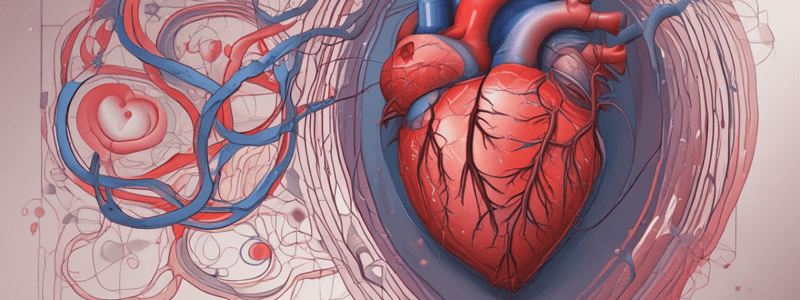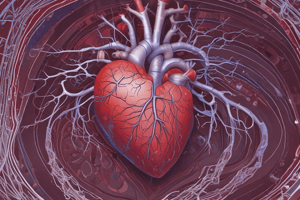Podcast
Questions and Answers
What is the primary purpose of beta blockers in the treatment of acute coronary syndrome?
What is the primary purpose of beta blockers in the treatment of acute coronary syndrome?
- To decrease heart rate and prolong diastole (correct)
- To dissolve thrombi
- To reduce myocardial oxygen demand
- To reduce platelet aggregation
What is the main difference between unstable angina and acute myocardial infarction?
What is the main difference between unstable angina and acute myocardial infarction?
- Degree of thrombosis (correct)
- Severity of chest pain
- Presence of ECG changes
- Response to rest
What is the primary mechanism of myocardial ischemia in acute coronary syndrome?
What is the primary mechanism of myocardial ischemia in acute coronary syndrome?
- Cardiac arrhythmias
- Increased myocardial oxygen demand
- Impaired vasodilation
- Decreased coronary blood flow due to thrombosis (correct)
What is the significance of Troponin elevation in acute myocardial infarction?
What is the significance of Troponin elevation in acute myocardial infarction?
What is the most common early complication of acute myocardial infarction?
What is the most common early complication of acute myocardial infarction?
What is the outcome of the healing process in acute myocardial infarction?
What is the outcome of the healing process in acute myocardial infarction?
What is the significance of ST elevation on ECG in acute myocardial infarction?
What is the significance of ST elevation on ECG in acute myocardial infarction?
What is the primary goal of revascularization in acute coronary syndrome?
What is the primary goal of revascularization in acute coronary syndrome?
What is the characteristic of chest pain in Stable Ischemic Heart Disease?
What is the characteristic of chest pain in Stable Ischemic Heart Disease?
What is the main reason for ischemia in Stable Ischemic Heart Disease?
What is the main reason for ischemia in Stable Ischemic Heart Disease?
Which area of the heart is more prone to ischemia?
Which area of the heart is more prone to ischemia?
What is the result of troponin release in the blood?
What is the result of troponin release in the blood?
What is the characteristic of cardiac enzymes in Stable Ischemic Heart Disease?
What is the characteristic of cardiac enzymes in Stable Ischemic Heart Disease?
What is the primary reason for the predictable pattern of chest pain in Stable Ischemic Heart Disease?
What is the primary reason for the predictable pattern of chest pain in Stable Ischemic Heart Disease?
What is the significance of ST depression during stress test in Stable Ischemic Heart Disease?
What is the significance of ST depression during stress test in Stable Ischemic Heart Disease?
What is the primary mechanism of ischemia in Stable Ischemic Heart Disease?
What is the primary mechanism of ischemia in Stable Ischemic Heart Disease?
What is the characteristic of cardiac enzymes in Stable Ischemic Heart Disease?
What is the characteristic of cardiac enzymes in Stable Ischemic Heart Disease?
Why is the subendocardial area more prone to ischemia in Stable Ischemic Heart Disease?
Why is the subendocardial area more prone to ischemia in Stable Ischemic Heart Disease?
What is the primary mechanism by which aspirin reduces the risk of acute coronary syndrome?
What is the primary mechanism by which aspirin reduces the risk of acute coronary syndrome?
What is the typical duration of necrotic cell recognition by macrophages in acute myocardial infarction?
What is the typical duration of necrotic cell recognition by macrophages in acute myocardial infarction?
What is the primary reason for cardiac remodeling in acute myocardial infarction?
What is the primary reason for cardiac remodeling in acute myocardial infarction?
What is the primary difference between non-ST elevation MI and ST elevation MI?
What is the primary difference between non-ST elevation MI and ST elevation MI?
What is the primary consequence of anaerobic metabolism in acute myocardial infarction?
What is the primary consequence of anaerobic metabolism in acute myocardial infarction?
What is the primary goal of anticoagulant therapy in acute coronary syndrome?
What is the primary goal of anticoagulant therapy in acute coronary syndrome?
What is the characteristic of cardiac enzymes in acute myocardial infarction?
What is the characteristic of cardiac enzymes in acute myocardial infarction?
What is the primary mechanism by which revascularization reduces the risk of future myocardial infarction?
What is the primary mechanism by which revascularization reduces the risk of future myocardial infarction?
Flashcards are hidden until you start studying
Study Notes
Ischemic Heart Disease Syndromes
- Stable Ischemic Heart Disease: chest pain, pressure, or tightness with activity, relieved with rest, due to narrowing of coronary artery by stable slow-growing atherosclerotic plaque
- Demand ischemia: occurs when demand increases, reversible when demand decreases (rest)
- Diagnosis:
- Normal ECG during rest
- ST depression during stress test
- Cardiac enzymes (troponin): negative (non-elevated)
- Treatments:
- Beta blockers (decrease HR, prolong diastole)
- Aspirin (reduce platelets aggregation)
Acute Coronary Syndrome
- Unstable Angina:
- Acute onset of chest pain/pressure at rest or unrelieved by rest
- Due to rupture of atherosclerotic plaque with thrombosis
- Supply ischemia: not related to demand
- Reversible ischemia if thrombus is broken down
- Infarction if thrombus keeps growing
- Subendocardial area is more prone to ischemia
- Diagnosis:
- Resting ECG (no need for stress test): ST depression
- Cardiac enzymes (troponin): negative
- Treatment:
- Anticoagulant
- Revascularization: reduces future MI
Acute Myocardial Infarction
- Acute onset of chest pain/pressure at rest or unrelieved by rest
- Due to rupture of atherosclerotic plaque with 100% thrombosis
- Main artery occlusion > transmural infarct
- Distal branch occlusion > subendocardial infarct
- Arterial thrombosis produces MI (necrosis, irreversible damage), not related to demand
- Pathological changes:
- Myocardium oxygen deprivation > switches to anaerobic metabolism > accumulation of lactate leading to calcium getting inside the cells > damage to the cell membrane > cellular death (necrosis)
- Necrosis starts within 30 minutes and completes within 6-12 hours
- At 12 hours, necrotic cells are recognized by macrophages that infiltrate dead tissues
- Macrophages then phagocyte necrotic cells within 3-7 days
- Fibrosis results by 6 weeks, replacing necrotic cells, function of the heart will diminish
- Diagnosis:
- Resting ECG (avoid stress test)
- ST depression: non-ST elevation MI (subendocardial infarction)
- ST elevation: ST elevation MI (transmural infarction)
- Troponin is elevated
- Early complications:
- Arrhythmias: most common, dead tissue is electrically unstable, most common cause of death
- Cardiogenic shock: dead tissue does not contract
- Acute rupture of cardiac structures: dead tissues are prone to tears
- Rupture of ventricular wall, septum, and papillary muscles
- Late complications:
- Pericarditis (Dressler syndrome): myocardial inflammation (infiltration of macrophages) spreads to adjacent pericardium
- Heart failure: infarcted segments (myocytes replaced by fibers) > cardiac wall is misshapen, leading to remodeling/changing ventricular shape > inefficient contractions
Ischemic Heart Disease Syndromes
- Stable Ischemic Heart Disease: chest pain, pressure, or tightness with activity, relieved with rest, due to narrowing of coronary artery by stable slow-growing atherosclerotic plaque
- Demand ischemia: occurs when demand increases, reversible when demand decreases (rest)
- Diagnosis:
- Normal ECG during rest
- ST depression during stress test
- Cardiac enzymes (troponin): negative (non-elevated)
- Treatments:
- Beta blockers (decrease HR, prolong diastole)
- Aspirin (reduce platelets aggregation)
Acute Coronary Syndrome
- Unstable Angina:
- Acute onset of chest pain/pressure at rest or unrelieved by rest
- Due to rupture of atherosclerotic plaque with thrombosis
- Supply ischemia: not related to demand
- Reversible ischemia if thrombus is broken down
- Infarction if thrombus keeps growing
- Subendocardial area is more prone to ischemia
- Diagnosis:
- Resting ECG (no need for stress test): ST depression
- Cardiac enzymes (troponin): negative
- Treatment:
- Anticoagulant
- Revascularization: reduces future MI
Acute Myocardial Infarction
- Acute onset of chest pain/pressure at rest or unrelieved by rest
- Due to rupture of atherosclerotic plaque with 100% thrombosis
- Main artery occlusion > transmural infarct
- Distal branch occlusion > subendocardial infarct
- Arterial thrombosis produces MI (necrosis, irreversible damage), not related to demand
- Pathological changes:
- Myocardium oxygen deprivation > switches to anaerobic metabolism > accumulation of lactate leading to calcium getting inside the cells > damage to the cell membrane > cellular death (necrosis)
- Necrosis starts within 30 minutes and completes within 6-12 hours
- At 12 hours, necrotic cells are recognized by macrophages that infiltrate dead tissues
- Macrophages then phagocyte necrotic cells within 3-7 days
- Fibrosis results by 6 weeks, replacing necrotic cells, function of the heart will diminish
- Diagnosis:
- Resting ECG (avoid stress test)
- ST depression: non-ST elevation MI (subendocardial infarction)
- ST elevation: ST elevation MI (transmural infarction)
- Troponin is elevated
- Early complications:
- Arrhythmias: most common, dead tissue is electrically unstable, most common cause of death
- Cardiogenic shock: dead tissue does not contract
- Acute rupture of cardiac structures: dead tissues are prone to tears
- Rupture of ventricular wall, septum, and papillary muscles
- Late complications:
- Pericarditis (Dressler syndrome): myocardial inflammation (infiltration of macrophages) spreads to adjacent pericardium
- Heart failure: infarcted segments (myocytes replaced by fibers) > cardiac wall is misshapen, leading to remodeling/changing ventricular shape > inefficient contractions
Studying That Suits You
Use AI to generate personalized quizzes and flashcards to suit your learning preferences.





